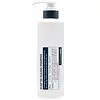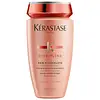What's inside
What's inside
 Key Ingredients
Key Ingredients

 Benefits
Benefits

 Concerns
Concerns

 Ingredients Side-by-side
Ingredients Side-by-side

Water
Skin ConditioningDisodium Laureth Sulfosuccinate
CleansingCocamidopropyl Hydroxysultaine
CleansingLauryl Glucoside
CleansingCocamide Mipa
EmulsifyingGlycerin
HumectantSodium Cocoyl Isethionate
CleansingSodium Chloride
MaskingPolygonum Multiflorum Root Extract
Skin ConditioningPropolis Extract
Skin ConditioningMentha Piperita Extract
CleansingPanthenyl Ethyl Ether
Panthenol
Skin ConditioningGaultheria Procumbens Leaf Extract
PerfumingThymus Vulgaris Extract
PerfumingJasminum Officinale Extract
MaskingAcorus Calamus Root Extract
PerfumingAngelica Gigas Root Extract
Skin ConditioningPanax Ginseng Root Extract
EmollientInositol
HumectantMilk Protein
Skin ConditioningNelumbo Nucifera Flower Extract
Skin ConditioningAlcohol
AntimicrobialHouttuynia Cordata Extract
Skin ConditioningAcetyl Cysteine
AntioxidantAcetyl Methionine
Skin ConditioningMalpighia Emarginata Fruit Extract
Skin ConditioningEuterpe Oleracea Fruit Extract
Prunus Serrulata Flower Extract
Skin ConditioningSalvia Officinalis Extract
AntimicrobialSalicylic Acid
MaskingPyrus Malus Fruit Extract
Skin ConditioningMorus Alba Bark Extract
Skin ConditioningPrunus Serotina Fruit Extract
MaskingPrunus Persica Fruit Extract
AbrasiveBetaine
HumectantBiotin
AntiseborrhoeicAdansonia Digitata Seed Extract
Skin ConditioningMenthol
MaskingSaccharomyces Cerevisiae Extract
Skin ConditioningChamomilla Recutita Extract
Skin ConditioningOriganum Majorana Leaf Extract
AntiseborrhoeicLactic Acid
BufferingLactose
HumectantLavandula Angustifolia Extract
Skin ConditioningMoringa Oleifera Seed Extract
Skin ConditioningCamellia Japonica Flower Extract
EmollientZiziphus Jujuba Fruit Extract
Skin ConditioningLaminaria Japonica Extract
Skin ProtectingNiacinamide
SmoothingGlycine Max Seed Extract
Skin ConditioningSodium Dehydroacetate
PreservativeCetyl Alcohol
EmollientZinc Pyrithione
AntiseborrhoeicPolyquaternium-10
Sodium Isethionate
CleansingCoconut Acid
CleansingCaprylyl Glycol
EmollientZinc Chloride
AntimicrobialArginine
MaskingCitric Acid
BufferingSodium Citrate
BufferingSodium Polynaphthalenesulfonate
Emulsion StabilisingButylene Glycol
HumectantDipropylene Glycol
HumectantDipotassium Glycyrrhizate
HumectantHydroxyacetophenone
AntioxidantDisodium EDTA
Phenoxyethanol
Preservative1,2-Hexanediol
Skin ConditioningParfum
MaskingWater, Disodium Laureth Sulfosuccinate, Cocamidopropyl Hydroxysultaine, Lauryl Glucoside, Cocamide Mipa, Glycerin, Sodium Cocoyl Isethionate, Sodium Chloride, Polygonum Multiflorum Root Extract, Propolis Extract, Mentha Piperita Extract, Panthenyl Ethyl Ether, Panthenol, Gaultheria Procumbens Leaf Extract, Thymus Vulgaris Extract, Jasminum Officinale Extract, Acorus Calamus Root Extract, Angelica Gigas Root Extract, Panax Ginseng Root Extract, Inositol, Milk Protein, Nelumbo Nucifera Flower Extract, Alcohol, Houttuynia Cordata Extract, Acetyl Cysteine, Acetyl Methionine, Malpighia Emarginata Fruit Extract, Euterpe Oleracea Fruit Extract, Prunus Serrulata Flower Extract, Salvia Officinalis Extract, Salicylic Acid, Pyrus Malus Fruit Extract, Morus Alba Bark Extract, Prunus Serotina Fruit Extract, Prunus Persica Fruit Extract, Betaine, Biotin, Adansonia Digitata Seed Extract, Menthol, Saccharomyces Cerevisiae Extract, Chamomilla Recutita Extract, Origanum Majorana Leaf Extract, Lactic Acid, Lactose, Lavandula Angustifolia Extract, Moringa Oleifera Seed Extract, Camellia Japonica Flower Extract, Ziziphus Jujuba Fruit Extract, Laminaria Japonica Extract, Niacinamide, Glycine Max Seed Extract, Sodium Dehydroacetate, Cetyl Alcohol, Zinc Pyrithione, Polyquaternium-10, Sodium Isethionate, Coconut Acid, Caprylyl Glycol, Zinc Chloride, Arginine, Citric Acid, Sodium Citrate, Sodium Polynaphthalenesulfonate, Butylene Glycol, Dipropylene Glycol, Dipotassium Glycyrrhizate, Hydroxyacetophenone, Disodium EDTA, Phenoxyethanol, 1,2-Hexanediol, Parfum
Water
Skin ConditioningSodium Cocoyl Isethionate
CleansingSodium Lauryl Sulfoacetate
CleansingDisodium Laureth Sulfosuccinate
CleansingSodium Lauroyl Sarcosinate
CleansingGlycol Distearate
EmollientCocamidopropyl Betaine
CleansingGlycereth-26
HumectantDecyl Glucoside
CleansingHydrogenated Coconut Acid
EmollientCoco-Betaine
CleansingPPG-5-Ceteth-20
EmulsifyingSodium Benzoate
MaskingDivinyldimethicone/Dimethicone Copolymer
Sodium Chloride
MaskingPolyquaternium-7
Amodimethicone
Polyquaternium-10
Sodium Isethionate
CleansingSalicylic Acid
MaskingPEG-55 Propylene Glycol Oleate
Propylene Glycol
HumectantCarbomer
Emulsion StabilisingC11-15 Pareth-7
EmulsifyingBenzoic Acid
MaskingArginine
MaskingGlutamic Acid
HumectantBenzyl Salicylate
PerfumingLaureth-9
EmulsifyingBenzyl Alcohol
PerfumingGlycerin
HumectantSerine
MaskingHydroxypropyltrimonium Hydrolyzed Wheat Protein
Skin ConditioningTrideceth-12
EmulsifyingC12-13 Pareth-23
Cleansing2-Oleamido-1,3-Octadecanediol
Skin ConditioningLinalool
PerfumingAlpha-Isomethyl Ionone
PerfumingC12-13 Pareth-3
EmulsifyingSodium Hydroxide
BufferingCitric Acid
BufferingParfum
MaskingWater, Sodium Cocoyl Isethionate, Sodium Lauryl Sulfoacetate, Disodium Laureth Sulfosuccinate, Sodium Lauroyl Sarcosinate, Glycol Distearate, Cocamidopropyl Betaine, Glycereth-26, Decyl Glucoside, Hydrogenated Coconut Acid, Coco-Betaine, PPG-5-Ceteth-20, Sodium Benzoate, Divinyldimethicone/Dimethicone Copolymer, Sodium Chloride, Polyquaternium-7, Amodimethicone, Polyquaternium-10, Sodium Isethionate, Salicylic Acid, PEG-55 Propylene Glycol Oleate, Propylene Glycol, Carbomer, C11-15 Pareth-7, Benzoic Acid, Arginine, Glutamic Acid, Benzyl Salicylate, Laureth-9, Benzyl Alcohol, Glycerin, Serine, Hydroxypropyltrimonium Hydrolyzed Wheat Protein, Trideceth-12, C12-13 Pareth-23, 2-Oleamido-1,3-Octadecanediol, Linalool, Alpha-Isomethyl Ionone, C12-13 Pareth-3, Sodium Hydroxide, Citric Acid, Parfum
 Reviews
Reviews

Ingredients Explained
These ingredients are found in both products.
Ingredients higher up in an ingredient list are typically present in a larger amount.
Arginine is an amino acid that is important for human development. Your body uses is it to produce hair keratin and skin collagen.
As a cosmetic ingredient, Arginine has antioxidant properties and can also help repair damaged skin. This ingredient is derived either synthetically or from animals.
Arginine isn't fungal acne safe when used in the presence of other lipids (fats, fatty acids, oils, esters, etc). Oils and fats occur naturally within the skin, so take caution when using Arginine if you're prone to fungal acne.
Learn more about ArginineCitric Acid is an alpha hydroxy acid (AHA) naturally found in citrus fruits like oranges, lemons, and limes.
Like other AHAs, citric acid can exfoliate skin by breaking down the bonds that hold dead skin cells together. This helps reveal smoother and brighter skin underneath.
However, this exfoliating effect only happens at high concentrations (20%) which can be hard to find in cosmetic products.
Due to this, citric acid is usually included in small amounts as a pH adjuster. This helps keep products slightly more acidic and compatible with skin's natural pH.
In skincare formulas, citric acid can:
While it can provide some skin benefits, research shows lactic acid and glycolic acid are generally more effective and less irritating exfoliants.
Most citric acid used in skincare today is made by fermenting sugars (usually from molasses). This synthetic version is identical to the natural citrus form but easier to stabilize and use in formulations.
Read more about some other popular AHA's here:
Learn more about Citric AcidThis ingredient is a cleansing agent, surfactant, and foam booster. It considered an alternative to traditional sulfates (Sulfosuccinate) and is allowed in "sulfate-free" products.
According to a manufacturer, this ingredient is mild and can be used in baby and bath options.
Glycerin is already naturally found in your skin. It helps moisturize and protect your skin.
A study from 2016 found glycerin to be more effective as a humectant than AHAs and hyaluronic acid.
As a humectant, it helps the skin stay hydrated by pulling moisture to your skin. The low molecular weight of glycerin allows it to pull moisture into the deeper layers of your skin.
Hydrated skin improves your skin barrier; Your skin barrier helps protect against irritants and bacteria.
Glycerin has also been found to have antimicrobial and antiviral properties. Due to these properties, glycerin is often used in wound and burn treatments.
In cosmetics, glycerin is usually derived from plants such as soybean or palm. However, it can also be sourced from animals, such as tallow or animal fat.
This ingredient is organic, colorless, odorless, and non-toxic.
Glycerin is the name for this ingredient in American English. British English uses Glycerol/Glycerine.
Learn more about GlycerinParfum is a catch-all term for an ingredient or more that is used to give a scent to products.
Also called "fragrance", this ingredient can be a blend of hundreds of chemicals or plant oils. This means every product with "fragrance" or "parfum" in the ingredients list is a different mixture.
For instance, Habanolide is a proprietary trade name for a specific aroma chemical. When used as a fragrance ingredient in cosmetics, most aroma chemicals fall under the broad labeling category of “FRAGRANCE” or “PARFUM” according to EU and US regulations.
The term 'parfum' or 'fragrance' is not regulated in many countries. In many cases, it is up to the brand to define this term.
For instance, many brands choose to label themselves as "fragrance-free" because they are not using synthetic fragrances. However, their products may still contain ingredients such as essential oils that are considered a fragrance by INCI standards.
One example is Calendula flower extract. Calendula is an essential oil that still imparts a scent or 'fragrance'.
Depending on the blend, the ingredients in the mixture can cause allergies and sensitivities on the skin. Some ingredients that are known EU allergens include linalool and citronellol.
Parfum can also be used to mask or cover an unpleasant scent.
The bottom line is: not all fragrances/parfum/ingredients are created equally. If you are worried about fragrances, we recommend taking a closer look at an ingredient. And of course, we always recommend speaking with a professional.
Learn more about ParfumPolyquaternium-10 is an ammonium salt of hydroxyethylcellulose. It is a white and granular powder used as a film-former and anti-static agent.
This ingredient is commonly found in hair conditioning products. According to a manufacturer, its positive charge makes it great for absorbing hair proteins. The manufacturer also states this ingredient helps with curl retention.
For haircare friends: this ingredient is not a silicone.
Learn more about Polyquaternium-10Salicylic Acid (also known as beta hydroxy acid or BHA) is a well-known ingredient for treating skin that struggles with acne and clogged pores. It exfoliates both the skin's surface and deep within the pores to help clear out buildup, control oil, and reduce inflammation.
Unlike AHAs (alpha hydroxy acids), salicylic acid is oil-soluble. This allows it to penetrate into pores which makes it especially effective for treating blackheads and preventing future breakouts.
Salicylic acid is also known for its soothing properties. It has a similar structure to aspirin and can calm inflamed or irritated skin, making it a good option for acne-prone skin that is also sensitive.
Concentrations of 0.5-2% are recognized by the U.S. FDA as an over-the-counter topical acne product.
It can cause irritation and/or dryness if one's skin already has a compromised moisture barrier, so it's best to focus on repairing that before introducing this ingredient into your routine.
While salicylic acid does not increase sun sensitivity, it’s still important to wear sunscreen daily to protect your skin.
If you are looking for the ingredient called BHA or Butylated Hydroxyanisole, click here.
Learn more about Salicylic AcidChances are, you eat sodium chloride every day. Sodium Chloride is also known as table salt.
This ingredient has many purposes in skincare: thickener, emulsifier, and exfoliator.
You'll most likely find this ingredient in cleansers where it is used to create a gel-like texture. As an emulsifier, it also prevents ingredients from separating.
There is much debate on whether this ingredient is comedogenic. The short answer - comedogenic ratings don't tell the whole story. Learn more about comegodenic ratings here.
The concensus about this ingredient causing acne seems to be divided. Research is needed to understand if this ingredient does cause acne.
Scrubs may use salt as the primary exfoliating ingredient.
Learn more about Sodium ChlorideSodium cocoyl isethionate is a natural ingredient from coconut oil. It is an ultra gentle cleanser that gives a nice foam without drying the skin or impacting the skin barrier.
The amount of foam created depends on the amount of sodium cocoyl isethionate used in the product.
This ingredient also helps improve the spreadability of a product.
Learn more about Sodium Cocoyl IsethionateWe don't have a description for Sodium Isethionate yet.
Water. It's the most common cosmetic ingredient of all. You'll usually see it at the top of ingredient lists, meaning that it makes up the largest part of the product.
So why is it so popular? Water most often acts as a solvent - this means that it helps dissolve other ingredients into the formulation.
You'll also recognize water as that liquid we all need to stay alive. If you see this, drink a glass of water. Stay hydrated!
Learn more about Water